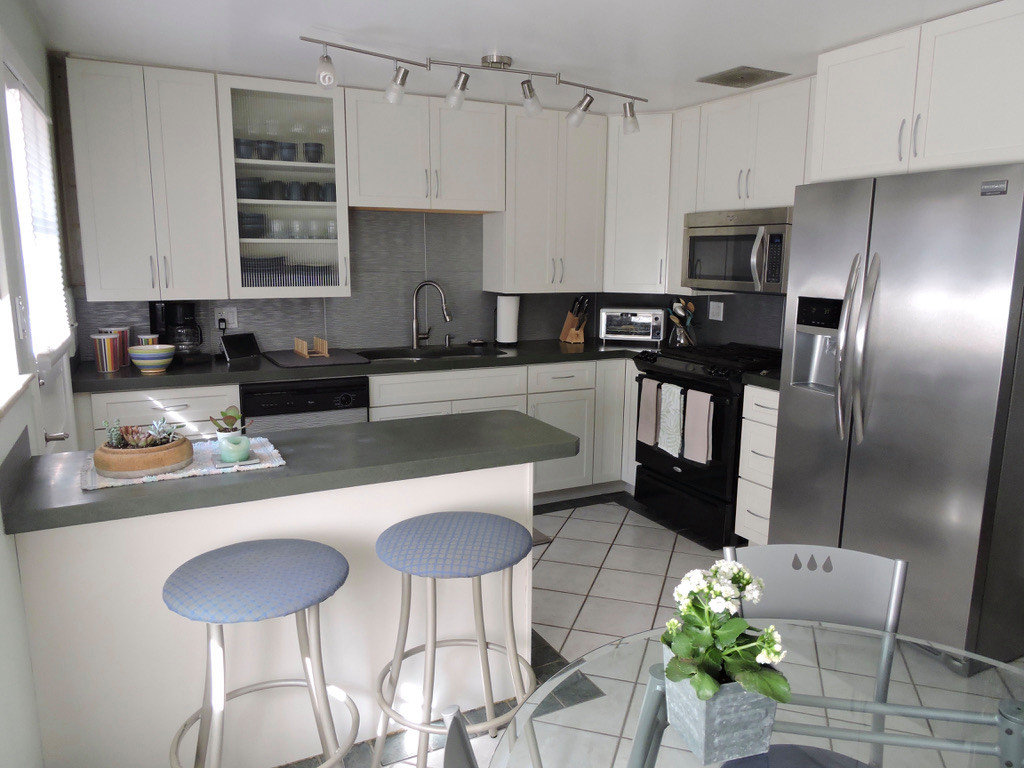Consultations: To Charge or Not?
Learn the pros and cons of paid, free and hybrid consultation options, with insight from expert working designers

Many designers rely on an initial consultation with a potential client to help them decide if the project and the person seem like a good fit. This valuable getting-to-know-you session sheds light on personality, expectations, design style and the budget — you as a designer are interviewing the clients as much as they’re interviewing you. But since not every consultation results in a project, should you charge for the time and effort you put into it, and if so, how much? Here we explore the pros and cons of four consultation options, as well as offer insight from expert designers, to help you decide what makes sense for you and your business.

First, Envision and Screen
Ideal client. Whether you end up deciding to charge for a consultation or not, knowing what your ideal customer and ideal project look like will simplify the process of screening inquiries and qualifying leads. So you’ll want to create a description of your ideal client, with must-have and nice-to-have characteristics. Answering the following questions can get you started.
Demographics
- What geographic areas do you want to work in, and would you be willing to travel?
- What is the ideal age range of your clients?
- Do they live alone, or do they have children, parents or housemates?
- What’s a good income range?
Project Logistics
- What types of projects do you most enjoy working on?
- What timeline works best?
- What project budget suits you best, and what’s the minimum amount you’d work with? (Tip: Research is your friend here. For instance, the median spend on kitchen remodels is $15,000; on bathrooms it’s $9,000, according to the 2022 Houzz & Home study.)
- What is your ideal client hoping to achieve with the project?
- What type of fee structure do you prefer, and what forms of payment will you accept? (Note: Many clients seek to use online payment options and credit cards.)
Work Style
- Do you prefer to work with clients who are hands on or hands off?
- What communication style works best for you?
- Are you willing to educate clients on the process, or would you prefer someone experienced?
Once you have a description of your ideal client, you can create a screening questionnaire to send to homeowners interested in working with you. Based on their answers, you’ll be able to get a better sense of whether scheduling a consultation makes sense.
Consultation structure. While you’re envisioning your ideal clients and projects, it’s also good to envision a structure for consultations you do take on. How much time are you willing to spend preparing and traveling? Will you offer consultations only over video or phone chat, or will you meet in person? How much time will you spend in the actual consultation? If prospective clients want something other than what you’ve decided on, that also can act as a valuable form of screening.

Option 1: Free Consultation
Pros: Opens the door to the most opportunities — especially valuable for newer business or if you’re otherwise short on leads. Gives you the chance to make a great impression to the most number of people, who might then refer you to others even if you don’t take on the projects. Lets you decide on a case-by-case basis whether you might let some of your desired client or project characteristics slide if all the others are in place. Lets you take on work in slow times that you might otherwise screen out. Helps you avoid the possible rut of always handling only one type of project or client.
Cons: You might waste time. Projects or clients might be completely out of your wheelhouse. Homeowners might just be looking for free advice, ideas or other information. Can distract you from focusing on projects you’ve already taken on, on marketing efforts to help bring in better-suited clients or on improving your business processes.
What the experts say:
“My office doesn’t charge a fee for the initial consult, as we see it as an opportunity to learn if the project is right for us just as much as if we are right for the owners. There are certainly times when folks have tried to take advantage and glean more information or ideas than is really appropriate, but it is up to us what we share and what we keep until an agreement on service has been reached,” says Heather Susemihl of McCall Design & Planning in McCall, Idaho.
“I abandoned the consultation fee. It was effective at weeding out tire kickers, but there have been many times when the ‘gifted’ 90 minutes of time has turned into hundreds of thousands of dollars over multiple projects,” says interior designer Jan Moyer of Rochester, New York.

Option 2: Paid Consultation
Pros: Ensures that you’re paid for your efforts even if the project doesn’t pan out. Conveys that your time and expertise are valuable. Can help screen out people looking for free advice.
Cons: Might deter some genuine prospects. Can put more pressure on you to work outside your comfort zone.
What the experts say:
“I have charged an in-home consulting fee for the past 15 years after a mentor convinced me that my time and knowledge were valuable. I request that a prospective client complete and return a questionnaire to me prior to our scheduled appointment…. By the end of the consultation, the homeowner has realistic budget parameters for their project criteria and a timeline for completion of work. The exchange is very equitable, and all parties feel respected,” says Molly McCabe of A Kitchen That Works in Bainbridge Island, Washington
“I charge $100 to go look at a new project. I have had people outright say no, and it saved me time. Traveling, measuring and listening all take time, not to mention quoting. While I know we feel the pressure to not charge for the consultation or deduct it later, I won’t deduct that fee, as it makes it look like the time I took to do the initial consult really wasn’t worth anything after all,” says drapery specialist Julie Thome in Redding, Connecticut
Tip: If you do charge a consulting fee, describe the value for potential clients. For example, will you give them ideas on color, provide a rough sketch with a layout, suggest materials, give them a budget estimate or offer any other takeaways?

Option 3: Paid but Credited to the Project
Pros: Protects your time investment. Offers clients a financial compromise. Can serve as an incentive for leads to research your business more before reaching out.
Cons: As with consultations paid for outright, you might deter some clients who just need motivation or inspiration to start a project. If you’re the one who decides it’s not a good fit after the consultation, keeping the fee might cause ill will, while waiving it would mean you won’t be compensated for your time.
What the experts say:
“For many years, I would do a free initial consultation, but I found that homeowners interview many different people for a job. I would spend a ridiculous amount of time just meeting potential clients. A good many of them just wanted free advice. When someone pays me to come out, I know that they are serious about hiring me. I’m happy to give potential clients ideas and advice, because they are paying for my time. I charge a fee that I deduct from the project if I am hired. For me it has been a win-win,” says Debbie Gliksman of Urban Oasis in Seattle.
“I have seen both sides of this equation, where I feel I will scare them off and also where I feel if they aren’t willing to value my expertise and time, they aren’t a fit for my business. I think I have come up with a fair solution. I now tell them the initial consultation is $150 and what it will cover: a reasonable meeting where we exchange ideas based on my expertise. I then tell them that I will refund half of this if they decide to move ahead with my firm. I have found that most are receptive to this,” says Jason Ballinger of JLB Design, who is licensed as an architect in New York, New Jersey and Indiana.

Option 4: Free, Brief Meeting Near You
Pros: Convenience — you won’t have to travel to the homeowner. If you meet in your office, you can perhaps show the person photos of previous projects, material samples or other helpful items without having to lug them anywhere. As this is a quick getting-acquainted meeting rather than a consultation, you’re opening the door to a wider range of prospects than if you didn’t offer this type of meeting, without the onus of having to provide extensive design advice. It creates less pressure for both you and the homeowner.
Cons: The person might try to turn the meeting into a free consultation. You might still spend a lot more time than you like on projects that don’t bear fruit. You might have to spend time keeping your workspace presentable.
What the experts say:
“I offer potential clients the option of coming to my office for a free 30-minute meeting. About 50% of the people who take me up on the offer end up hiring me,” says Theresa Guthals of Pikes Peak Interiors in Colorado Springs, Colorado.
“I offer a free 30-minute meeting if the meeting is to take place at my office; but traveling to them, which usually takes at least two hours, if not three or four, simply doesn’t often enough result in an accepted proposal for a free consultation to make sense,” says residential architect Don R. Titus in Portland, Oregon.
Tip: Be very clear upfront about the parameters and time frame of the meeting, and stick to them.
Regardless of which consultation you choose, using a designer-specific platform with lead generation help and a CRM feature can bring more prospects in the door and keep all of your communications and appointments with prospective and actual clients organized and manageable. Consider starting a free trial of Houzz Pro, the preferred all-in-one solution for many designers with business big and small!
The information contained in this article should not be relied upon as legal, business, or tax advice. We encourage you to seek guidance from your legal counsel, business or tax specialist with regard to how the information contained in this article may or may not apply specifically to your business.
Join the conversation by commenting or asking a question below. The Houzz team reads every single comment, and we’ll get back to you by email if you need us!

Want advice delivered to your inbox?
Unlock industry insights and updates for contractors and design pros
By signing up, I agree to the Houzz Terms of Use and Privacy Policy and that Houzz may use my information to contact me about relevant content, products, and services.













All About You - Ann & Angelo Cane